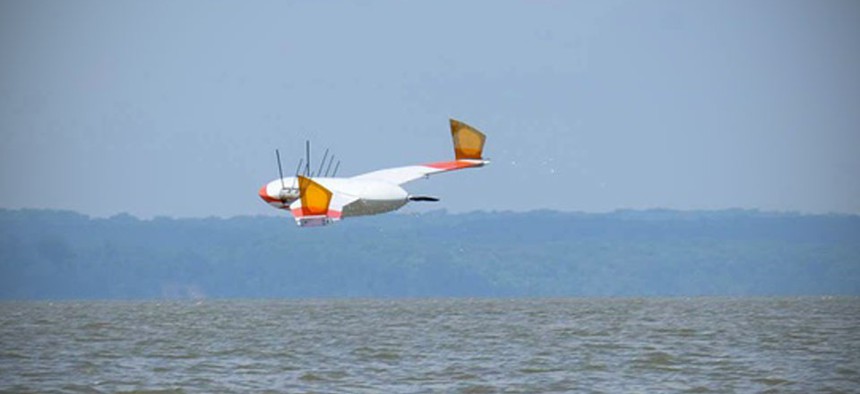This Duck Drone Could Spy on Enemy Subs

Naval Research Lab
But building a flying-and-swimming robot is harder than nature makes it look.
Nature, which has no need for devices that spy on enemy submarines from the air and underwater, may nevertheless have invented their form: flying fish, for example, or ducks that can zoom over the water’s surface and dive beneath to feed. But the Navy Research Lab, or NRL, which is working on a new drone that can both fly and swim, is learning that combining robots for two different purposes is not as easy as nature makes it look.
Why does the Navy need duck drones? Simply put: flying is faster than swimming, largely because water is 1,000 times denser than air. Consider that the common MK 46 torpedo makes at best 50 mph, while sea-skimming missiles can do five times that speed.
While nature has found a way to accommodate the variety of physical forces that can act upon complex swimming and flying systems, humans have yet to figure this out. Submersible undersea drones, made thick-skinned to withstand water pressures, are generally heavy or equipped with complicated ballast systems. Aerial drones, conversely, are as light as possible, and rarely designed to crash into water.
“For a submarine to fly, the enclosed air volume, which is the main driver of weight for a submarine, needs to be reduced as much as possible. For an aircraft to land on the water, its structural elements need to be more robust to survive the high impact of splashdown.” Dan Edwards, a principal investigator for NRL, writes in the most recent issue of the lab’s Spectra magazine.
Under its Flimmer program (for “flying swimmer”), the NRLteam built a “Test Sub” — basically a submarine with wings —and simply worked around the fact that it was heavier than the typical drone. They took it on at least three test runs, dropping it from a plane at 1,000 feet. The test sub flew well enough, according to Edwards’s account, performing “as any other aircraft, controllable in three axes and exhibiting sufficient stability for man-in-the-loop flight.” The team then guided it along the surface of the water at 40 knots (about 46 miles per hour) “before sending it beneath the waves where it performed like a regular UUV,” or unmanned underwater vehicle.
The “Test Sub was guided along a standard approach at an airspeed of approximately 40 knots before splashdown with wings level,” writes Edwards. “Upon touching the water surface, the aircraft saw a dramatic increase in drag and decelerated abruptly. After the splash, Test Sub submerged and started moving underwater and was responsive to human controls … Test Sub cruises well above 50 knots in the air, while top speed in the water is below 10 knots, illustrating the ultimate benefit of a flying submarine: assuring quick reaction access to underwater areas.”
The team is experimenting now with floodable wings and more fishlike designs such as the lab’s experimental “Wrasse-inspired Agile Near-shore Deformable-fin Automaton,” orWANDA. Built to mimic the movement of a fish called the bird wrasse, the WANDA’s moving fins may prove too fragile for a machine hitting the water at relatively high speed.
“A four-finned configuration provides high maneuverability and good stability underwater. In air, however, the fins add weight and are relatively fragile mechanisms that need to be able to survive the forces of splashdown. Bringing all these design elements together is the central challenge of the Flimmer program,” writes Edwards.
The team has begun to adjust WANDA’s design for flight and will spend the rest of the year fine-tuning and tweaking the design.
The future of flying fish drones looks neither like a bird, nor a fish, but something new entirely.



